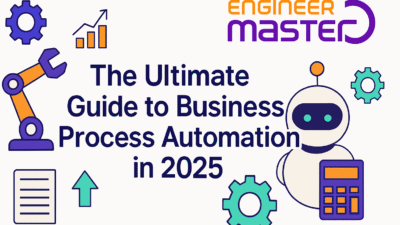Introduction
TL;DR Running a small business means wearing multiple hats. You handle customer service in the morning. You manage inventory by afternoon. Evening brings accounting tasks. This cycle exhausts even the most dedicated entrepreneurs.
AI automation for small business operations under budget offers a solution. You don’t need enterprise-level investments. Small businesses can access powerful automation tools for under $1000. These tools handle repetitive tasks. Your team focuses on growth activities.
The automation revolution isn’t just for tech giants anymore. Small businesses now compete with larger competitors through smart technology choices. This guide shows you exactly how to implement AI automation for small business operations under budget. You’ll discover practical tools. You’ll learn implementation strategies. You’ll see real results without breaking your bank account.
Table of Contents
Understanding AI Automation Benefits for Budget-Conscious Small Businesses
AI automation transforms how small businesses operate. The technology handles mundane tasks automatically. Your staff redirects energy toward creative problem-solving and customer relationships.
Cost savings appear immediately. One automated email sequence replaces hours of manual follow-ups. A chatbot answers common questions 24/7. Your team no longer stays late answering repetitive inquiries.
Productivity jumps when automation enters your workflow. Tasks that took three hours now complete in fifteen minutes. Data entry happens automatically. Invoice processing requires no human intervention.
Customer experience improves dramatically. Automated systems respond instantly. Clients receive immediate acknowledgment of their requests. Nobody waits until business hours for basic information.
Small businesses gain competitive advantages through automation. You match the responsiveness of larger companies. Your operations run smoothly even with limited staff. Customers perceive your business as professional and efficient.
Error rates drop significantly. Humans make mistakes when tired or distracted. Automated systems maintain consistent accuracy. Your financial records stay clean. Customer communications contain no typos.
Identifying High-Impact Automation Opportunities in Your Business
Start by examining your daily operations. Which tasks consume the most time? Where do bottlenecks occur? These areas deserve automation priority.
Customer communication represents prime automation territory. Email responses follow predictable patterns. Chat inquiries repeat the same questions. Social media messages require similar answers.
Administrative work drains resources unnecessarily. Appointment scheduling involves endless back-and-forth emails. Invoice creation follows identical steps. Data entry pulls staff away from valuable work.
Marketing activities consume significant hours. Social media posting requires daily attention. Email campaigns need regular creation and scheduling. Lead nurturing demands consistent follow-up.
Sales processes contain repetitive elements. Lead qualification follows standard criteria. Follow-up emails use similar templates. Meeting scheduling wastes time across multiple calendars.
Track how your team spends each hour for one week. Document every task. Note duration and frequency. This audit reveals your best automation candidates.
Calculate the cost of manual processes. Multiply hours spent by hourly wages. Add opportunity costs of delayed strategic work. These numbers justify automation investments.
Essential Low-Cost AI Tools for Small Business Automation
AI automation for small business operations under budget requires selecting the right tools. Several platforms deliver enterprise features at small business prices.
Zapier connects different applications without coding knowledge. The platform automates workflows between 5000+ apps. Plans start at $19.99 monthly. Free tiers handle basic automation needs.
ChatGPT provides AI-powered writing assistance. The tool drafts emails, creates content, and answers questions. Free access includes powerful capabilities. Premium plans cost $20 monthly.
Make (formerly Integromat) offers visual workflow automation. The platform handles complex multi-step processes. Free plans include 1000 operations monthly. Paid tiers start at $9.
Calendly eliminates scheduling headaches. The tool syncs with your calendar automatically. Clients book appointments without email exchanges. Free plans cover basic needs. Premium features cost $10 monthly per user.
Mailchimp automates email marketing campaigns. The platform segments audiences and triggers personalized messages. Free plans support up to 500 contacts. Paid options begin at $13 monthly.
Tidio combines live chat with AI chatbots. The service handles customer inquiries around the clock. Free plans include basic chatbot features. Upgraded versions start at $29 monthly.
QuickBooks Online automates accounting tasks. The software categorizes expenses and generates financial reports. Plans begin at $30 monthly. The investment saves countless bookkeeping hours.
Implementing Customer Service Automation on a Tight Budget
Customer service automation delivers immediate ROI. Clients expect fast responses. Automated systems meet these expectations without expanding your team.
Install a chatbot on your website. These AI assistants answer frequent questions instantly. Tidio and ManyChat offer affordable chatbot builders. You create conversation flows using simple interfaces.
Program your chatbot with common inquiries first. Product information, pricing details, and shipping policies represent starting points. The bot handles these queries without human intervention.
Set up automated email responses. Create templates for order confirmations, shipping notifications, and support ticket acknowledgments. Customers appreciate immediate feedback.
Use AI-powered help desk software. Systems like Freshdesk organize customer inquiries automatically. Tickets route to appropriate team members. Priority levels assign based on keywords.
Implement FAQ automation through your website. Tools like AnswerDash predict customer questions. The system displays relevant help articles proactively. Support volume decreases as clients find answers independently.
Create video tutorials for complex topics. Record screen demonstrations showing common procedures. Upload content to YouTube. Embed videos in support articles. Customers solve problems visually.
Monitor chatbot conversations regularly. Identify questions the bot can’t answer. Add new responses to improve coverage. Your automation becomes more capable over time.
Automating Marketing Tasks Without Breaking Your Budget
Marketing automation multiplies your reach without multiplying costs. AI automation for small business operations under budget shines brightest in marketing activities.
Schedule social media posts in advance. Buffer and Hootsuite offer free plans for basic scheduling. Create a month of content in one sitting. Posts publish automatically at optimal times.
Set up email drip campaigns. New subscribers receive a welcome series automatically. The sequence educates prospects about your offerings. Conversion rates improve through consistent nurturing.
Use AI writing assistants for content creation. Tools like Copy.ai and Jasper generate blog posts, social captions, and ad copy. You edit and refine AI-generated drafts. Content production speeds up dramatically.
Implement lead scoring automation. Assign point values to prospect behaviors. Email opens, link clicks, and page visits increase scores. Your team prioritizes high-scoring leads.
Create automated segmentation rules. Divide your email list based on behaviors and preferences. Send targeted messages to specific groups. Relevance increases engagement rates.
Set up retargeting pixels on your website. Facebook and Google track visitor behavior. Automated ads follow interested prospects across the internet. Your marketing budget works harder.
Generate automated reports for marketing performance. Tools like Google Data Studio compile metrics automatically. You review results without manual data collection. Decision-making accelerates with clear insights.
Streamlining Sales Processes Through Affordable AI Solutions
Sales automation removes friction from your revenue generation. Representatives spend more time selling and less time on administrative tasks.
Implement a basic CRM system. HubSpot offers robust free plans for small teams. The platform tracks customer interactions automatically. Sales history appears in one centralized location.
Automate lead capture from multiple sources. Web forms, chat conversations, and email inquiries flow into your CRM automatically. No leads slip through the cracks.
Set up automated follow-up sequences. New leads receive immediate responses. Subsequent emails arrive on scheduled intervals. Your sales process maintains momentum automatically.
Use AI tools for meeting notes and summaries. Otter.ai transcribes sales calls automatically. The service highlights action items and key points. Representatives focus on conversations instead of note-taking.
Create proposal templates with automated customization. Tools like PandaDoc merge client information into professional documents. Proposals generate in minutes rather than hours.
Implement e-signature capabilities. DocuSign and HelloSign offer pay-as-you-go pricing. Clients sign contracts electronically. Deal closure accelerates without printing and scanning.
Set up automated pipeline management. CRM systems move deals between stages based on activities. Sales managers receive notifications when deals stall. Forecasting becomes data-driven rather than guesswork.
Automating Financial Operations and Bookkeeping Tasks
Financial automation prevents costly errors and saves significant time. AI automation for small business operations under budget includes powerful accounting solutions.
Connect your bank accounts to accounting software. Transactions import automatically. QuickBooks and Wave categorize expenses using AI. Monthly reconciliation takes minutes instead of hours.
Automate invoice creation and delivery. Generate invoices from completed work orders automatically. Email invoices to clients without manual intervention. Payment reminders send on predetermined schedules.
Set up automatic expense tracking. Apps like Expensify scan receipts using image recognition. Categories assign automatically. Expense reports compile without manual data entry.
Implement automated payment collection. Stripe and PayPal process transactions automatically. Recurring billing happens on schedule. Cash flow improves with faster collections.
Use AI for financial forecasting. Tools analyze historical data and predict future trends. You spot cash flow issues before they become critical. Planning becomes proactive rather than reactive.
Automate tax preparation workflows. Accounting software tracks deductible expenses throughout the year. Tax reports generate with a few clicks. Your accountant receives organized records.
Set up automated financial alerts. Receive notifications when account balances drop below thresholds. Monitor unusual spending patterns automatically. Financial surprises become rare occurrences.
Building Efficient Internal Communication and Workflow Automation
Internal operations benefit enormously from automation. Team productivity increases when information flows smoothly.
Implement project management automation. Asana and Trello offer free plans with automation features. Tasks assign automatically based on triggers. Team members receive notifications about relevant updates.
Create automated onboarding workflows. New employees receive training materials on scheduled intervals. Account access provisions happen automatically. HR staff focus on personal connections rather than paperwork.
Set up automated time tracking. Tools like Toggl run in the background. Time entries categorize by project automatically. Payroll processing and project billing become straightforward.
Use automated document management. Google Workspace and Microsoft 365 organize files automatically. Version control happens without manual tracking. Teams collaborate without confusion.
Implement automated approval workflows. Purchase requests route to appropriate managers automatically. Expense approvals follow predetermined paths. Decision-making accelerates across your organization.
Create automated status update systems. Slack bots collect team progress reports. Managers receive summaries without scheduling meetings. Everyone stays informed efficiently.
Set up automated backup systems. Cloud storage services sync files automatically. Disaster recovery becomes automatic rather than afterthought. Business continuity improves dramatically.
Creating Your Step-by-Step Implementation Plan
Successful automation requires methodical planning. Random tool adoption creates confusion and wasted investment.
Start with one department or process. Master that automation before expanding. IT teams call this approach “crawl, walk, run.” Early wins build momentum and confidence.
Document your current processes thoroughly. Map each step in workflows you plan to automate. Identify decision points and exceptions. Clear documentation prevents automation failures.
Choose tools that integrate well together. Check compatibility before purchasing. Platforms that connect easily create powerful automation chains. Isolated tools limit your potential.
Train your team on new systems properly. Schedule dedicated learning time. Create simple guides for common tasks. Automation only works when people use it correctly.
Test automations extensively before full deployment. Run parallel processes during transition periods. Verify accuracy and reliability. Catch issues in controlled environments.
Set measurable goals for each automation. Define success metrics clearly. Track time savings, error reduction, and cost decreases. Data proves ROI and guides future decisions.
Schedule regular reviews of automated systems. Technology and business needs change constantly. Update workflows quarterly. Remove automations that no longer serve your goals.
Maximizing ROI From Your AI Automation Investment
Getting maximum value from AI automation for small business operations under budget requires strategic thinking.
Focus on high-frequency tasks first. Automations that run daily or hourly deliver faster returns. Occasional processes can wait for later implementation phases.
Calculate true automation costs including setup time. Some “cheap” tools require extensive configuration. Factor in learning curves and maintenance needs. True cost differs from subscription prices.
Leverage free trials aggressively. Most automation platforms offer 14-30 day trials. Test thoroughly during trial periods. Commit only after confirming value.
Combine multiple automations into workflows. Individual automations save time. Connected automation chains transform entire processes. The whole exceeds the sum of parts.
Monitor time savings religiously. Track hours recovered through automation. Calculate dollar values of reclaimed time. These metrics justify continued investment and expansion.
Reinvest time savings into revenue activities. Automation fails if recovered time goes to waste. Direct freed resources toward growth initiatives. ROI multiplies when automation enables better work.
Share automation wins across your organization. Celebrate time savings and efficiency gains. Success stories inspire adoption and innovation. Automation culture spreads through positive examples.
Overcoming Common Implementation Challenges
Every business faces obstacles when implementing automation. Preparation helps you navigate these challenges successfully.
Resistance from team members appears frequently. People fear job loss or change. Address concerns directly and honestly. Frame automation as eliminating drudgery, not eliminating jobs.
Technical complexity intimidates many small business owners. Modern automation tools require no coding skills. Visual interfaces make workflow creation intuitive. Start simple and build confidence gradually.
Integration issues frustrate many implementations. Not all tools connect smoothly. Research compatibility before purchasing. Choose platforms with robust integration libraries.
Data quality problems undermine automation effectiveness. Garbage in equals garbage out. Clean your data before automating processes. Establish data entry standards across your team.
Budget constraints limit tool selection. Prioritize ruthlessly based on impact. One powerful automation beats five mediocre ones. Quality trumps quantity with limited resources.
Maintenance requirements catch businesses off guard. Automated systems need occasional updates. Business rules change. Customer needs evolve. Budget time for ongoing optimization.
Overautomation creates rigid processes. Leave room for human judgment. Some situations require flexibility. Build override options into critical workflows.
Real-World Success Stories and Budget Breakdowns
Actual examples prove AI automation for small business operations under budget works for real businesses.
A local bakery automated their order management system. Customers place orders through an online form. Orders flow into the bakery’s system automatically. Email confirmations send instantly. The owner invested $200 in form software and $30 monthly for email automation. Weekly time savings total eight hours.
A consulting firm automated their proposal process. Templates pull client information from their CRM automatically. E-signatures close deals without printing. The investment included $25 monthly for PandaDoc and $0 for HubSpot’s free CRM. Proposal creation time dropped from four hours to thirty minutes.
A retail shop implemented customer service automation. A chatbot answers sizing questions and shipping inquiries. The business uses Tidio’s $29 monthly plan. Customer service tickets decreased by 40%. The owner handles the remaining complex inquiries personally.
A marketing agency automated their social media scheduling. Content creation happens in monthly batches. Posts publish automatically across platforms. Buffer’s free plan handles three social accounts. The team reclaimed ten hours weekly for client strategy work.
A landscaping company automated their appointment scheduling and reminders. Calendly eliminates phone tag with prospects. Automated SMS reminders reduce no-shows. Total monthly cost reaches $25. The owner books 30% more consultations monthly.
Building Your Custom Automation Stack Under $1000
Creating an effective automation system requires strategic tool selection. Here’s a complete stack that stays within budget.
Customer Service Stack – $58/month: Tidio chatbot ($29), Help Scout basic plan ($20), and Calendly essentials ($9). This combination handles inquiries, organizes support tickets, and manages appointments.
Marketing Automation Stack – $87/month: Mailchimp standard plan ($20), Buffer business ($15), Copy.ai starter ($49), and Canva Pro ($3). Create, schedule, and deploy marketing content across channels.
Sales Automation Stack – $95/month: HubSpot free CRM ($0), PandaDoc essentials ($25), Otter.ai pro ($17), and Calendly essentials ($9), plus Zapier starter plan ($30). Manage leads, create proposals, and track conversations.
Financial Operations Stack – $60/month: QuickBooks Simple Start ($30) and Expensify basic ($5 per user). Track income, expenses, and generate financial reports automatically.
Project Management Stack – $49/month: Asana premium ($13.49 per user for 3 users) or Monday.com basic ($8 per user for 3 users). Automate task assignments and team workflows.
Total Monthly Investment: Approximately $349 monthly or $4,188 annually. This exceeds your budget, so prioritize based on your specific needs.
Recommended Starting Stack – $83/month ($996 annually): QuickBooks Simple Start ($30), Mailchimp standard ($20), Tidio chatbot ($29), and Zapier starter ($30). This core setup automates your most time-consuming activities. Add additional tools as budget allows and ROI proves itself.
Scaling Your Automation as Your Business Grows
Automation needs evolve as your business expands. Plan for growth from the beginning.
Choose platforms with upgrade paths. Free and starter plans should scale to advanced tiers. Switching tools later wastes time and money. Evaluate long-term viability during initial selection.
Document your automation workflows thoroughly. Create process maps showing how automations connect. Future team members need this knowledge. Documentation enables smooth transitions and expansions.
Build modular automation systems. Individual workflows should function independently. Modular design allows piece-by-piece upgrades. You avoid massive system overhauls.
Monitor capacity limits on your tools. Most platforms restrict usage on lower tiers. Watch for approaching limits. Upgrade before hitting walls that disrupt operations.
Train multiple team members on critical automations. Knowledge concentration creates vulnerability. Distribute expertise across your team. Operations continue smoothly when key people are unavailable.
Evaluate new automation opportunities quarterly. Business growth reveals new automation candidates. Regular reviews keep your stack current. Your automation matures alongside your company.
Invest automation savings into additional automation. Create a virtuous cycle of efficiency. Each automation funds the next. Your business compounds productivity gains over time.
Frequently Asked Questions About AI Automation for Small Businesses
How much technical knowledge do I need to implement AI automation?
Modern automation tools require no coding skills. Visual interfaces guide you through workflow creation. Most small business owners successfully implement basic automations within hours. Complex scenarios might require help from affordable freelancers.
Will automation replace my employees?
Automation eliminates tedious tasks, not jobs. Your team redirects energy toward creative and strategic work. Most small businesses use automation to grow without hiring additional staff. Existing employees handle higher-value activities.
How long does it take to see ROI from automation investments?
Most businesses see returns within 30-90 days. Simple automations like email scheduling provide immediate benefits. Complex workflow automations require longer setup but deliver larger returns. Track time savings weekly to measure progress.
Can I automate my entire business?
Some processes shouldn’t be automated. Personal customer relationships require human touch. Complex decision-making needs human judgment. Aim to automate 40-60% of routine tasks. Balance efficiency with personal service.
What happens if automated systems fail?
Build backup plans for critical processes. Monitor automations regularly for errors. Most platforms offer high reliability rates above 99%. Maintain manual process documentation for emergencies. Test disaster recovery procedures periodically.
How do I choose between similar automation tools?
Evaluate integration capabilities first. Tools that connect with your existing systems deliver more value. Test free trials extensively. Check user reviews from businesses similar to yours. Consider long-term costs including potential upgrades.
Is my business too small for automation?
No business is too small for automation. Solo entrepreneurs benefit from basic email and scheduling automation. Even part-time side hustles gain competitive advantages. Start with one simple automation and expand gradually.
How do I maintain data security with automation?
Choose reputable platforms with strong security track records. Enable two-factor authentication on all accounts. Review access permissions regularly. Encrypt sensitive data before uploading to cloud platforms. Security doesn’t require expensive enterprise tools.
Read More:-Leveraging AI Automation Solutions to Streamline Business Processes
Conclusion

AI automation for small business operations under budget transforms how you compete in modern markets. You don’t need massive investments to gain efficiency advantages. Strategic automation under $1000 delivers remarkable returns.
Start with your biggest time drains. Customer service, marketing, and administrative tasks offer immediate wins. Select tools that integrate well together. Build your automation stack incrementally as budget allows.
Track your time savings religiously. Calculate dollar values of recovered hours. These metrics prove ROI and justify expansion. Reinvest freed time into revenue-generating activities.
Your competition already uses automation. Delaying implementation means falling behind. Small investments in AI automation for small business operations under budget create compounding advantages over time.
Success doesn’t require technical expertise. Modern platforms democratize powerful capabilities. You can implement professional-grade automation using intuitive interfaces. Your business deserves these advantages.
Take action today by identifying one process to automate. Choose a tool and implement your first workflow. Experience the power of reclaimed time. Your journey toward efficient operations begins with a single automation.
The future belongs to businesses that work smarter through technology. AI automation for small business operations under budget puts that future within your reach right now. Your competitors won’t wait. Neither should you.





